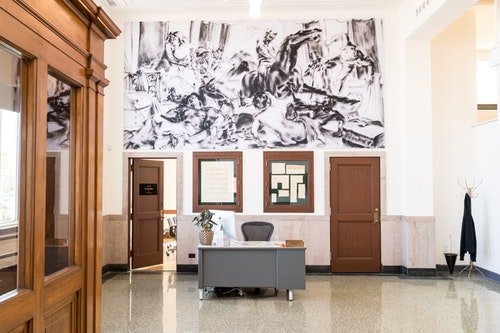When Mobelux acquired a significant building, a former 1939 Post Office located on Broad Street in Richmond, between the ever-growing Virginia Commonwealth University, and the up-and-coming Scotts Addition, I knew it was a gem. The building, in use as a Post Office for 80 years up until demolition began, was full of stories and natural beauty, it was just covered underneath years of paint.
Historical Context
One of the first things I dug in on was the history of the building. I uncovered stories over the years charting the modern progress of technology as it made postal workers’ jobs obsolete (one stamp machine in particular in 1955 dispensed stamps 40% faster than older systems, and about how a switch from two-tone mailboxes to a single-color (blue) netted them a $4000 yearly savings, in addition to uncovering the history behind Clyde Saunders, the building's namesake. When the Mobelux Brand Director Rob began designing elements to occupy the standard postal bulletin boards that adorned the lobby wall, we used a collection of these "clippings" to pay homage to the past.
I researched, documented, and produced stories, and media, and collaborated with the Mobelux team to design and develop content for the physical spaces.
The Binford Mural
During my research, I uncovered one thread that led me to one of the most transformative stories I would discover. In 1942, a few years into the building's life, a round of the WPA Arts Program, the largest federally public arts initiative this country has ever undertaken, denoted money for a WPA Mural to hang in the lobby of Saunders Station. A local artist, Julien Binford, who at that point was represented in New York City and had shown in Paris was selected. His first sketch, a full-sized 8' x 16' charcoal canvas won the approval of the Federal Arts Commission and Federal Building Commission, but due to the subject matter, the burning of Richmond, the piece was protested, censored, and never completed.
My research led me to the National Archives, The Virginia Museum of Fine Arts, The Library of Virginia, and The Valentine, where I uncovered photographs, letters, and personal effects from the artist, all of which shaped the building. Eventually, I discovered that the mural he'd submitted, which had been photographed by The VMFA staff, now lived in a high-resolution photograph within the National Archives Collection, and Mobelux was able to digitize the piece and reproduce it for display in the location it was originally designated for. Replacing it in the lobby completed the story for Mobelux, and allowed us to weigh in on the debate we could have otherwise left untouched.
USING HISTORY TO WRITE A NEW STORY
Mobelux at Saunders Station — 2016
RESEARCH, INTERIOR DESIGN, SOURCING, CONTENT PRODUCTION, PUBLIC RELATIONS, EVENT PLANNING, COMMUNITY ENGAGEMENT
Awards and recognition:
Richmond Times-Dispatch, "Eight development projects given Golden Hammer awards for best projects in Richmond"
Richmond BizSense, "Golden Hammers double this year"
Richmond Times-Dispatch, "'Richmond Burning': How a controversial mural of Richmond went up 75 years after it was created"
Style Weekly, "Architecture Review: A Post Office Restoration on West Broad Raises the Bar for Historic Renovation in Richmond"






